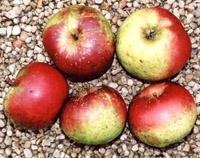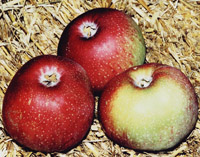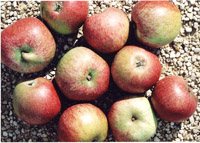
 |
|||||
|
|
|||||
|
|
|
|||||
|
|
 |
MAY QUEEN Raised in 1888 by Mr Haywood of Worcester. An excellent and attractive dessert apple, very sweet, fruity and with very crisp, juicy flesh. Ready to pick in October, it will store until April. Crops are often heavy. Free spur bearing and compact growth. One of the best. Pollination Group 4 |
||
 |
McINDOE’S RUSSET This apple was noted in the National Apple Register of 1971, referring to the Journal of the Royal Horticultural Society as being new in 1895 and late season, but with no further information. We were aware that the only and last source of this apple was in the Grove Heritage Collection in Tasmania and we received scions from them in 2005. The apple is a late season russet – and of considerable merit. We speculate that the originator of this apple was the Mr McIndoe who was head gardener to Sir Joseph Pease at Hutton Hall, Guisborough, North Yorkshire, once famous for its Fernery. A uniformly russeted small to medium sized apple, ripe only in November, with greenish flesh, sweet, rich, juicy and tangy. It will keep well, the flavour maturing, with careful storage. Pollination Group 4 |
|||
 |
MEADFOOT
WONDER A delicious mid-season dessert apple introduced to us
by Mr and Mrs Peter Clarke of Benson, Oxfordshire. Mr Clarke’s grandfather
built his house in 1928 within an old mature orchard at the edge of the
village, and several old trees remain. This one is certainly 100+ years
old evidenced by a ring count from a section of the trunk, the tree having
died a few years ago. The round, smooth-skinned apples are pale yellow
with some russet at the stalk and bright carmine and crimson broken stripes.
The flesh is tender, very sweet and crisp, with a rich flavour that is
best in September. Apples will keep well into October and usually longer.
The original name is now lost and it has been renamed Meadfoot Wonder
after the house name. Pollination Group 4 |
|||
 |
MELA
CARLA A very old Italian apple from the Turin region, the name
meaning Apple of Charles. The Latin name for it is Pomum Caroli Magni,
again a reference to Charlemagne who approved of it in the 8-9th century.
The official first reference to it is in 1817. It is possibly the second
oldest surviving apple after Decio. A juicy white-fleshed sweet apple
which, in good summers or on warm sites develops a rich flavour, scented
of roses. Medium sized apples of pale yellow and darkish crimson, ripe
in October and storing until January. Showy rich pink blossom. Pollination
Group 2 |
|||
 |
MELON
An American apple that originated with Heman Chapin, from East Bloomfield,
in New York State around 1800 in Ontario County. It was in the RHS collection
before the early 1860s and became widely grown in Hertfordshire, Kent,
Somerset and Surrey, having been included in the Rivers’ and Scott’s
nursery catalogues. The fruit is conical, irregular, with warm yellow
skin, striped and flushed with crimson and carmine. Apples are crisp,
juicy, sweet and perfumed. Hogg (1884) deemed it ‘of great excellence’.
Trees are upright and compact. Pick October and store until January. Pollination
Group 5 |
|||
 |
MÈRE
DE MÉNAGE Flanders Pippin, Queen Emma. A European late
culinary apple, possibly Belgian, known from 1780. Very large and impressive
apples, with deep carmine stripes and sweet, but pleasantly tart, flesh.
It was once valued for Apple Charlotte as it kept its shape when cooked
and turned pink. Ready to pick in late October, the fruit stores until
late winter. Part tip bearing. T*. Pollination Group 3 |
|||
 |
MILLER'S
SEEDLING Raised by Mr Miller, a nurseryman of Newbury, Berkshire,
in 1848. An early dessert apple, starting to drop in August, which should
be eaten soon after picking for the best flavour, though the apples will
last for a few weeks. A very decorative fruit, with a creamy skin flushed
and streaked with coral pink and red, and with sweet, crisp, juicy flesh.
Heavy crops. Trees fruit when quite young. Free spurring. Pollination
Group 3 |
|||
 |
MILLOINI While on a perambulation of fruit trees in the Oxfordshire village of Islip, in the company of local residents, Alison Butler and Justin Stead, we came across a modestly sized tree on an allotment, where all the apples had dropped, as one, by early September. The apples were consistent in shape, long and with a snouty end, broadly rich carmine and over a pale base. Returning at a later date, we met the allotment owner – Brigitte Milloini. The apple was bred from a pip by her father, Ron Milloini, and planted on his allotment some time after 1948, the year he took over the allotment. The apples are medium to small, reasonably crisp and not dry, with a good, fruity, sweet flavour and quite excellent for an early season apple. Sometimes there is a little red under the skin. We suspect it would also make a rich cider, given the flavour. Islip was on the ancient route from London to Worcester where a ford across the River Ray provided passage and the River Cherwell to the west could be avoided. Around the year 1003, Emma of Normandy gave birth to the future King Edward the Confessor, while passing through. He died in 1066 and the Battle of Hastings ensued to decide his successor. Pollination Group 6
|
|||
 |
MILTON
WONDER This important tree was owned by Mrs Lillian Marlow, before
moving in 2013. It is nationally important for its age, provenance and
current stage of growth, as well as for its excellent fruit. It is not
a variety whose original name can still be ascertained. Mrs Marlow, then
in her 90s, had lived at the property all her life, except for four years
during the war. Her grandparents bought the old village granary at Milton,
Oxfordshire, in 1912, complete with a thatched roundhouse, used by a stonemason.
The house dates from the 1700s. Already in the garden and mature, was
one particular apple tree. Her grandfather, Mr William Dearlove - a professional
gardener - was told by the previous owner that the apple tree was nearly
100 years old in 1912. In 2020, it would be over 200 years old. The original
Bramley’s Seedling tree is probably a few years older, though the
timing is a little hazy, and the ‘English Greening’ in America
(see separate entry in this catalogue) is 194 in 2020. There are no other
known trees of this age with a clear provenance. It is possible that the
Bramley is a bit younger and the Milton Apple a bit older, so they could
be of equal status. Despite being struck by lightning in the 1960s the
tree remained very healthy, though the trunk was split, twisted and hollow.
We use the past tense because we are unsure if the tree survives. When
Mrs Marlow left her cottage some disgraceful events occurred (Mrs Marlow
was not responsible) and plans were made to develop the house and garden,
which would have condemned the tree in time. The Vale of the White Horse
Council fell over themselves in their haste to do nothing, while their
officers developed acute deafness, and the plans were passed. Remarkably,
this tree was nourished by a sinuous, rounded strand of living bark, separate
and inside the hollow trunk. The tree was undergoing regeneration - and
a new lease of life. There are many ancient apples of unknown age and
our field work suggests they may well live to 250-300 years, quite apart
from those which fall, re-root and send up new trunks, which can theoretically
live forever. The original Bramley fell and regrew. Milton Wonder is/was
the oldest known domestic apple tree which remained upright. The tree
has impressive white blossom and excellent quality dessert fruit from
mid-October, crisp, juicy and rich. Sometimes it only fully ripens in
November. It is also good for cooking, softening slowly and keeping its
shape, with a full flavour, though it is best as a dessert apple. Apples
will store until June in most years. The matt skin is flushed with dark
red, over dark green, with some russet flecks. The apples are medium sized
and round with obscure ribs. Pollination Group 4 |
|||
|
||||